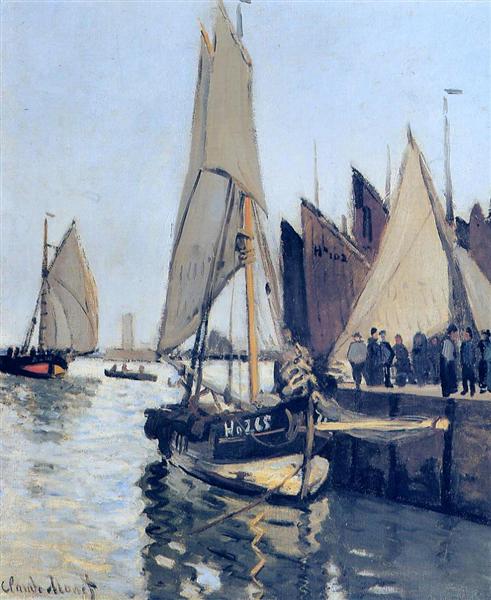Description
Claude Monet's Sailboats at Honfleur (1866) is a brilliant example of the Impressionist style that marked a revolutionary shift in the perception and depiction of landscape. Honfleur, a picturesque port on the Normandy coast of France, was a recurring location for 19th-century artists, and Monet, with his acute sensitivity to light and atmosphere, captures the essence of this setting in a work that exudes movement and color.
Looking at the painting, one immediately notices the well-structured composition, which seems to flow organically. Sailboats, with their sails unfurled, become the central focus of this scene, sailing gracefully in the calm water of the harbor. The arrangement of the vessels creates a visual narrative that invites the viewer to contemplate not only the landscape, but the daily lives of those who live and work in this marine environment. Monet suggests a sense of action and dynamism; although there are no clearly visible human figures, the light reflected in the water and the movement of the boats infuse the work with a palpable vitality.
The use of colour in Sailboats at Honfleur is exceptionally striking. Monet employs a palette that harmonises various shades of blue and green for the water, while the sails of the boats contrast delicately with the nearby softness of the clouds. The nuances in the reflections on the water are masterfully managed, revealing the painter's concern for capturing the fleeting effects of light that characterise his work. This search for natural light becomes a hallmark of Impressionism and, in this painting, Monet makes beautiful use of pastel tones that evoke the tranquillity of an afternoon in the harbour.
Compositionally, the painting is balanced by a blurred background, suggesting the remoteness and atmosphere of the place. Shapes on the horizon are hinted at rather than clearly defined, allowing the viewer's gaze to focus on the closest and most palpable elements, in this case, the sailboats. This semi-abstraction technique reinforces the idea that the natural world is itself a set of sensory perceptions rather than a literal and concrete representation.
This work is rich in history, as it represents a period when Monet was beginning to establish himself within the Impressionist movement. He and other contemporary artists would often gather in places like Honfleur, such as Eugène Boudin, who influenced Monet by encouraging him to capture the landscape in nature, away from the studio. This background contextualizes the importance of the work not only on a technical and stylistic level, but also as part of a broader artistic dialogue that was developing at the time.
"Sailboats at Honfleur" also invites reflection on the impact of light and atmosphere in art. At the time Monet painted this piece, Impressionism became a means of exploring transitory moments, a quest that continues to resonate in contemporary art. By capturing the ephemeral essence of light at dusk, Monet not only offers a portrait of the landscape but also delves into deeper concepts of experience and perception.
In short, Sailboats at Honfleur is a rich work that encapsulates the essence of Impressionism and Claude Monet's unique ability to capture the landscape in motion. The grace of its sailboats and the subtle dialogue between color and light position this painting not only as an object of aesthetic admiration, but as a milestone in the evolution of modern painting.
KUADROS ©, a famous painting on your wall.
Hand-made oil painting reproductions, with the quality of professional artists and the distinctive seal of KUADROS ©.
Painting reproduction service with satisfaction guarantee. If you are not completely satisfied with the replica of your painting, we will refund 100% of your money.

